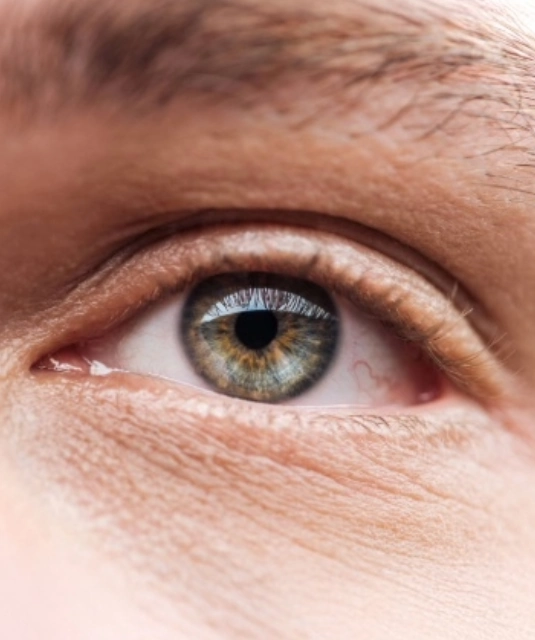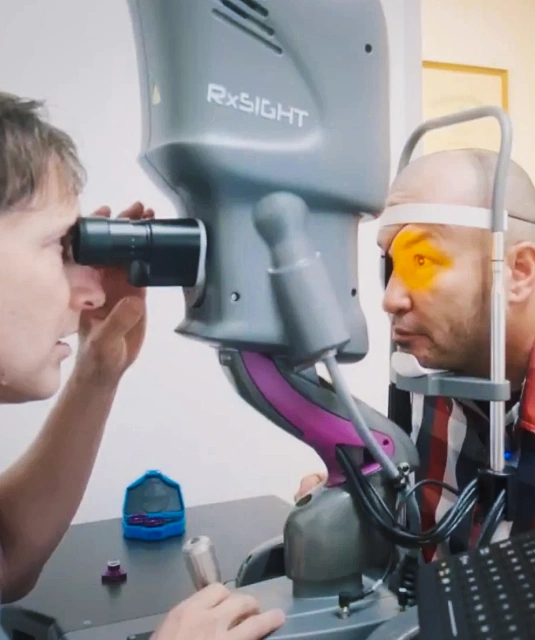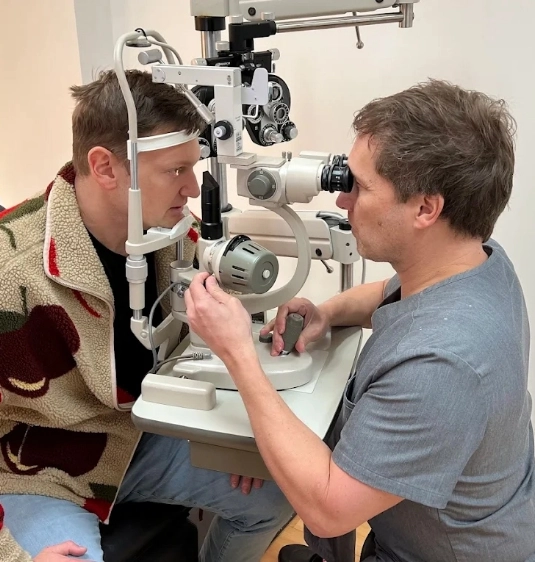
Refractive Lens Exchange (RLE)
If you’re over 40 and starting to rely on reading glasses or noticing changes in your vision, refractive lens exchange (RLE) may be the solution. This advanced procedure replaces the eye’s natural lens with a custom intraocular lens (IOL) to correct nearsightedness, presbyopia, farsightedness, astigmatism, and more—while also preventing future cataracts.

Dr. Rex Hamilton performs RLE at a state-of-the-art vision center in Beverly Hills, serving patients from across Los Angeles. With decades of experience in refractive surgery and a personalized approach to lens-based vision correction, Dr. Hamilton helps patients achieve lasting clarity—often with less dependence on eyeglasses or contact lenses.
RLE at a Glance
Refractive lens exchange (RLE) is a vision correction procedure that replaces the eye’s natural lens with an artificial intraocular lens (IOL) which stays the same and does not degrade for the rest of the patient’s life. RLE treats presbyopia, astigmatism, nearsightedness, and farsightedness — preventing future cataracts and often eliminating the need for glasses. It’s ideal for adults over 40 seeking long-term clarity.
- What is Refractive Lens Exchange?
- What Vision Problems Can RLE Treat?
- Top Benefits of Refractive Lens Exchange Surgery
- Am I a Good Candidate for RLE Eye Surgery?
- Explore Your Intraocular Lens (IOL) Options
- How to Prepare for Your RLE Procedure
- What Happens During Refractive Lens Exchange?
- Recovery After Refractive Lens Exchange
- Why Choose Dr. Rex Hamilton?
- FAQs About Refractive Lens Exchange

What is Refractive Lens Exchange?
Refractive lens exchange (RLE)—sometimes called clear lens extraction—is a vision correction procedure that replaces the eye’s natural lens with an advanced intraocular lens (IOL). While nearly identical to cataract surgery, RLE is performed electively, before a cataract has developed, to correct refractive errors such as presbyopia, farsightedness, nearsightedness, and astigmatism.
By removing the aging or dysfunctional lens of the eye and implanting a custom IOL, RLE offers a broader range of correction than procedures like LASIK, PRK, or even EVO ICL™—for patients over 40. It also eliminates the future need for cataract surgery, since the lens where cataracts would form has already been replaced.
Performed as a quick, outpatient surgical procedure using state-of-the-art technology, RLE is an excellent option for those seeking sharper distance vision, improved near vision, and a reduced need for eyeglasses or reading glasses.
What Vision Problems Can RLE Treat?
Refractive lens exchange (RLE) is designed to correct a wide range of refractive errors—issues with how light is focused onto the retina that result in blurry vision. By replacing the eye’s natural lens with a customized intraocular lens implant (IOL), RLE addresses both distance and near vision challenges that often come with age.
Common conditions treated with RLE include:
- Presbyopia: This age-related condition typically begins in your 40s and makes it harder to focus on nearby objects. RLE replaces the aging lens with a premium multifocal lens or light adjustable lens, often reducing the need for
Trusted Source Presbyopia American Optometric Association Go to Source reading glasses.
- Hyperopia (Farsightedness): People with farsightedness see better at a distance than up close and may have never needed glasses until they need readers. RLE improves near vision by correcting the eye’s focusing power with a clear,
Trusted Source Hyperopia (farsightedness) American Optometric Association Go to Source artificial lens.
- Myopia (Nearsightedness): If you’re nearsighted, distant objects appear blurry without corrective glasses or contact lenses. RLE is appropriate for the correction of myopia in patients who already have presbyopia, typically over the age of
Trusted Source Myopia (nearsightedness) American Optometric Association Go to Source 40.
- Astigmatism: Caused by an irregular shape of the cornea, astigmatism distorts vision at
Trusted Source What is Astigmatism? American Academy of Ophthalmology Go to Source all distances.
RLE can correct this using a toric type of IOL, or with precise incisions placed in the cornea, improving both clarity and focus.4
By customizing the intraocular lens to your unique prescription and visual goals, RLE can significantly improve your quality of life—helping you enjoy clearer vision without relying on eyeglasses or contact lenses.
Ready to take the next step? Schedule your RLE consultation in Beverly Hills today.
Top Benefits of Refractive Lens Exchange Surgery
Refractive lens exchange (RLE) offers more than just vision correction—it provides a long-term solution for patients over 40 seeking independence from glasses, contact lenses, and the future burden of cataract surgery. Dr. Rex Hamilton performs RLE in Beverly Hills using state-of-the-art technology including advanced diagnostics and premium intraocular lens (IOL) technology for safe, effective, and personalized results.

Key Benefits of Refractive Lens Exchange
Permanent Vision Correction
RLE corrects presbyopia, astigmatism, nearsightedness, and farsightedness in a single surgical procedure, using an artificial lens that never ages or clouds.
Customized IOL Options
Patients can choose from a range of advanced IOLs, including toric lenses for astigmatism, multifocal lenses for distance and reading vision, and the innovative Light Adjustable Lens™ for post-surgical fine-tuning. Dr. Hamilton has extensive experience with all IOL types and will make a recommendation as to which IOL type is best for each patient’s unique situation.
Fast and Comfortable Recovery
With precise measurements and femtosecond laser technology, RLE is performed on both eyes the same day with efficiency and accuracy—often resulting in clearer vision by the next day.
No Need for Future Cataract Surgery
Since RLE replaces the eye’s natural lens, cataracts cannot develop—thus eliminating the need for cataract removal later in life.
Improved Quality of Life
Most patients enjoy a significant reduction in their dependence on eyeglasses and reading glasses, with clearer vision at multiple distances.

Am I a Good Candidate for RLE Eye Surgery?
Refractive lens exchange (RLE) is often the preferred option for patients over 40 who want to correct age-related vision changes and reduce dependence on reading glasses, contact lenses, or eyeglasses.
You may be a candidate for RLE if you are over 40 and:

- You experience presbyopia or other vision changes
- You have farsightedness, nearsightedness, or astigmatism
- You’re tired of juggling reading glasses or progressive lenses
- You’ve been told you’re not a candidate for LASIK surgery
- You want to prevent cataracts and avoid surgery later in life
- Your eyes are healthy and free from glaucoma, macular degeneration, or uncontrolled dry eyes
During your consultation at Dr. Hamilton’s Los Angeles ophthalmology practice, a detailed exam will determine whether RLE is the safest and most effective path to clearer vision—both now and in the years ahead.
Find out if refractive lens exchange is right for your eyes—book a visit with Dr. Hamilton in Beverly Hills.
Explore Your Intraocular Lens (IOL) Options
One of the most important decisions in refractive lens exchange (RLE) is selecting the right intraocular lens (IOL). Thanks to today’s advanced technology, there are more ways than ever to personalize your vision correction. Whether you’re hoping to reduce dependence on reading glasses, address astigmatism, or achieve sharper vision at all distances, Dr. Rex Hamilton will recommend the best option based on your visual goals, lifestyle, and eye anatomy.
Monofocal IOLs
Monofocal lenses offer a single fixed point of focus, typically set for distance vision. While they are the most traditional option, they do not correct astigmatism or presbyopia, so most patients will still need glasses to see clearly at distance and for near or intermediate tasks.
Light Adjustable Lens™ (LAL)
The Light Adjustable Lens by RXSight is the first and only IOL that can be customized after it’s implanted. Using targeted UV light treatments, your vision can be precisely adjusted post-surgery, offering a truly personalized outcome.
Toric IOLs
For individuals with astigmatism, toric lenses offer targeted correction by addressing both the shape of the cornea and refractive error. Toric options are available in monofocal, multifocal, and EDOF varieties, allowing for tailored visual outcomes.
Advanced Intraocular Lens (IOL) Options
RLE provides the opportunity to select from several premium lenses designed to enhance your visual range and reduce dependence on glasses:
Multifocal & Extended Depth of Focus (EDOF) IOLs
These high-performance lenses are engineered to deliver sharp vision across multiple distances. They can help you see clearly at near, far, and intermediate ranges—minimizing the need for reading glasses or bifocals.
Explore your lens options in person—schedule a consultation at our Beverly Hills office.
Advanced Lens Surgery Patient Experience

How to Prepare for Your RLE Procedure
Your refractive lens exchange (RLE) journey starts with a personalized consultation at Dr. Rex Hamilton’s practice in Beverly Hills, where we take the time to understand your vision goals and assess whether RLE is right for you. From your first visit to your final follow-up, our goal is to make your experience smooth, informed, and focused on long-term results.
Before Your Consultation
To ensure precise measurements and customized IOL selection, you may need to pause contact lens use:
- Soft contact lenses: Stop wearing 3 to 5 days before your visit
- Hard or gas-permeable lenses: Discontinue at least 2 weeks in advance
Bringing your eyeglasses or a photo of your contact lens packaging or prescription is helpful for establishing your baseline correction. We’ll also review your eye health, corneal imaging, and lifestyle to determine which intraocular lens best supports your goals.
Pre-Surgery Instructions
Once your RLE procedure is scheduled, Dr. Hamilton’s team will provide detailed pre-op guidance, which may include:
- Medication review: Share a full list of current medications, supplements, and eye drops—some may need to be paused
- Avoid irritants: Do not wear eye makeup, lotions, or face creams the day before and day of surgery
- Plan for transportation: A trusted adult must drive you home, as your vision will be temporarily blurry after surgery and a mild sedative will typically have been administered.
From consultation to recovery, Dr. Hamilton’s experienced team offers expert support and state-of-the-art ophthalmology care—so you feel confident and prepared every step of the way.
What Happens During Refractive Lens Exchange?
Refractive lens exchange (RLE) is a quick, outpatient eye surgery that typically takes about 10 to 15 minutes per eye. In most circumstances, both eyes can be treated on the same day. While the procedure is nearly identical to cataract surgery, it is performed electively to correct refractive errors like presbyopia, farsightedness, nearsightedness, and astigmatism. Here’s what to expect on the day of your procedure at Dr. Rex Hamilton’s Beverly Hills ophthalmology practice:
Arrival and Preparation
You’ll be greeted by our team and guided through the pre-operative process. To ensure a comfortable experience:
- Anesthetic eye drops are applied to fully numb the eye
- A mild oral sedative may be given to help you relax
- Operative eyes are dilated
Plan to spend about 1.5 to 2 hours at the surgery center to allow time for preparation and post-procedure monitoring.
The RLE Procedure
Using precision microsurgical techniques—often with the assistance of a femtosecond laser—Dr. Hamilton:
- Makes a tiny incision at the edge of the cornea
- Gently removes the eye’s natural lens using advanced phacoemulsification technology
- Inserts a customized intraocular lens implant (IOL)—selected based on your prescription, goals, and eye anatomy
The incision is self-sealing and typically does not require stitches. Each step is performed with care, precision, and the support of state-of-the-art technology.
Immediate Recovery
After surgery, you’ll rest briefly in our recovery area before heading home with post-op instructions and a supply of eye drops. A trusted adult must drive you, as your vision will be temporarily blurry and you may be sleepy from administered sedative medication.


“Refractive lens exchange is one of the most transformative procedures we offer. For the right patient, it restores clarity, reduces visual dependence, and eliminates the risk of cataracts—all in one step.”– Dr. Rex Hamilton
Recovery After Refractive Lens Exchange
Recovery after refractive lens exchange (RLE) is typically fast, low-maintenance, and very comfortable. Most patients report noticeably clearer vision within the first 24 hours—especially with multifocal or Light Adjustable Lenses. Here’s what to expect during your healing process:
First 24 Hours
You may experience mildly blurry vision, dryness, or a scratchy sensation in the treated eye. These symptoms are temporary and often resolve quickly. To protect your eye, for the first week:
- Wear a protective shield while sleeping
- Avoid rubbing your eyes or getting water in them (no swimming, shower is fine but no water in eyes)
- Refrain from strenuous activity including impact (e.g. jumping, running) or bending over with head past waist (e.g. pilates, yoga)
First Month
Follow-up visits will be scheduled to monitor your progress and ensure proper healing. If you selected the Light Adjustable Lens, you’ll begin a series of light-based adjustments to fine-tune your prescription after the eye has fully healed.
First Week
Your vision will continue to stabilize as your eye adjusts to the new intraocular lens implant (IOL). Dr. Hamilton will prescribe antibiotic and anti-inflammatory eye drops to reduce inflammation and support healing. Most patients return to work and resume normal activities within 24 to 48 hours.
Long-Term Results
Because RLE replaces the natural lens before cataracts develop, it permanently eliminates the need for cataract surgery in the future. Most patients enjoy sharp, stable vision with reduced or eliminated dependence on eyeglasses or reading glasses—leading to long-term visual freedom and improved quality of life.
Additional Procedures following RLE
Almost all patients will require a 2 minute laser procedure called YAG Capsulotomy at some point after RLE or cataract surgery. This treats some scarring that typically occurs in the lens capsule (native tissue) that contains the IOL implant. This YAG procedure is done in the office using only topical numbing drops. There are no restrictions following the YAG procedure and it only needs to be done one time as the scarring does not recur.

Why Choose Dr. Rex Hamilton for LASIK in Beverly Hills?
When it comes to refractive lens exchange (RLE), few surgeons bring the depth of experience, academic leadership, and personalized care that Dr. Rex Hamilton offers. A board-certified ophthalmologist and recognized authority in refractive surgery, Dr. Hamilton has spent decades at the forefront of lens-based vision correction. Dr. Hamilton is one of the pioneers in the Los Angeles area for performing bilateral (same day) RLE surgery instead of performing RLE on one eye at a time.
As the former Director of the UCLA Laser Refractive Center, Dr. Hamilton has trained the next generation of eye surgeons, contributed to clinical advancements in cataract surgery, and helped refine the use of premium intraocular lens (IOL) technology. His research has been widely published in peer-reviewed ophthalmology journals, including studies on IOL selection, cataract surgery outcomes, and innovations in lens power optimization.
At his state-of-the-art eye care center in Beverly Hills, Dr. Hamilton personally performs all consultations, testing, and surgeries. From initial diagnostics to post-op follow-ups, you’ll receive consistent, expert care—never handed off to another provider.
Whether you’re seeking to correct presbyopia, reduce reliance on reading glasses, or find a solution after LASIK or PRK, Dr. Hamilton offers a thoughtful, data-driven approach tailored to your vision goals.
FAQs About Refractive Lens Exchange
The procedures are nearly identical—both involve replacing the natural lens with an intraocular lens (IOL). The key difference is timing: refractive lens exchange (RLE) is elective and performed proactively, before cataracts develop, while cataract surgery is done reactively, once the natural lens has become cloudy. RLE can be performed in both eyes on the same day while most cataract surgeries are performed on one eye at a time.
LASIK reshapes the cornea using a laser, while RLE replaces the lens of the eye with an artificial implant. RLE is often better suited for patients with presbyopia, high hyperopia, or those over 40 seeking a more permanent solution.
Yes. Toric IOLs and other advanced lenses can correct astigmatism, helping reduce distortion and improve clarity at all distances. Dr. Hamilton may also choose to use a femtosecond laser to place precise, image guided incisions, called astigmatic keratotomy (AK) or limbal relaxing incisions (LRI), in the cornea to round out its shape, thus reducing astigmatism. The AK or LRI incisions are done during the same session as the RLE procedure.
Yes—many patients who had LASIK surgery years ago choose RLE later in life to address age-related vision changes like presbyopia or early cataracts. During your consultation, Dr. Hamilton will thoroughly evaluate your eyes to determine if RLE is appropriate and which IOL design is best suited for each individual situation.
Typically no. The procedure is performed with numbing eye drops, and most patients feel only mild pressure on the eye. You may also receive a mild sedative to help you relax.
RLE is a safe and well-established surgical procedure, but like all forms of eye surgery, there are rare risks. These may include infection, inflammation, IOL dislocation, or retinal
Trusted Source
Cataract Surgery
American Academy of Ophthalmology
Go to Source
detachment.
Dr. Hamilton will review your risk profile and answer all questions during your consultation.
Your outcome depends on the type of intraocular lens selected, but many patients experience sharper vision at multiple distances and a reduced need for eyeglasses or reading glasses. Results improve as your eyes heal and adapt. Multifocal/EDOF IOLs offer the widest range of vision without glasses. These IOLs also have night halos associated with them. As the brain adapts to the new optics, the halos become less apparent and patients typically stop noticing them within the first few months following surgery.
RLE is designed to be permanent. Once your natural lens is replaced, you won’t develop cataracts in the future—making RLE both a vision correction and preventive solution. A simple in-office 2 minute laser procedure called YAG Capsulotomy is typically needed around 6 months to a year following surgery to clean up some mild scar tissue that can develop behind the IOL. There are no restrictions following this quick procedure and the scar tissue does not return.
Most people return to work and daily routines within 1–2 days. You’ll be given detailed instructions to support your recovery and protect your results.
Dr. Hamilton offers a full range of premium IOL options, including monofocal, toric, multifocal, accommodating, extended depth of focus, small aperture, and the Light Adjustable Lens™. Your lens will be selected based on a collaborative effort between you and Dr. Hamilton, based on your visual goals, prescription, and lifestyle.
RLE is an elective procedure, so it’s typically not covered by insurance. However, many patients use HSA/FSA funds or take advantage of financing options to make treatment more affordable.
The cost of refractive lens exchange depends on the type of IOL, your prescription, and your overall treatment plan. During your consultation, you’ll receive a personalized quote and guidance on payment and financing options.
1 American Optometric Association. Presbyopia. Available: https://www.aoa.org/healthy-eyes/eye-and-vision-conditions/presbyopia?sso=y. Accessed June 1, 2025.
2 American Optometric Association. Hyperopia (farsightedness). Available: https://www.aoa.org/patients-and-public/eye-and-vision-problems/glossary-of-eye-and-vision-conditions/hyperopia. Accessed June 1, 2025.
3 American Optometric Association. Myopia (nearsightedness). Available: https://www.aoa.org/patients-and-public/eye-and-vision-problems/glossary-of-eye-and-vision-conditions/myopia. Accessed July 1, 2025.
4 American Academy of Ophthalmology. What is Astigmatism? Available: https://www.aao.org/eye-health/diseases/what-is-astigmatism. Accessed June 1, 2025.
5 American Academy of Ophthalmology. Cataract Surgery. Available: https://www.aao.org/eye-health/diseases/what-is-cataract-surgery. Accessed July 1, 2025.